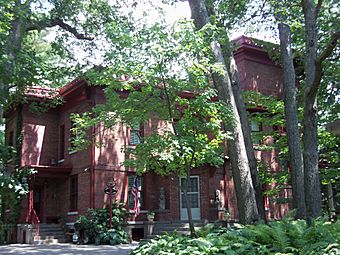John Schricker House facts for kids
Quick facts for kids |
|
|
John Schricker House
|
|
 |
|
| Location | 5418 Chapel Hill Rd. Davenport, Iowa |
|---|---|
| Area | 3 acres (1.2 ha) |
| Built | 1910 |
| Architect | Clausen & Clausen |
| MPS | Davenport MRA |
| NRHP reference No. | 85000776 |
| Added to NRHP | April 9, 1985 |
The John Schricker House is a special old building in Davenport, Iowa. It's a historic home that was added to the National Register of Historic Places in 1985. This means it's an important place that helps us understand history.
About John C. Schricker
John Schricker was a skilled builder who worked with stone and marble. He helped create important structures in Iowa. For example, he worked on the Dillon Memorial in downtown Davenport. He also helped build the Iowa Soldiers' and Sailors' Monument. This monument is located at the Iowa State Capitol in Des Moines.
In 1895, Schricker became a business partner. He joined Captain Chris Schricker and F.G. Roddler. Together, they started the Davenport Pearl Button Company. This company made buttons from clam shells. These shells were gathered from the Mississippi River. Their business operated until the 1930s. John Schricker hired a local architecture firm called Clausen & Clausen. They designed his house, which was built between 1909 and 1910.
House Design and Style
The Villa style of Italianate architecture was very popular in Davenport. This was especially true in the 1870s and 1880s. Many of these homes were built on top of bluffs. Their tall towers offered amazing views of the Mississippi River Valley.
John Schricker built his second important house in Davenport on a bluff. This area, on the far west side of the city, is still quite rural. The John Schricker House is one of the last homes in Davenport built in the Italianate Villa style. It's a simpler, more modern version of the style. The house has a plain brick outside. It doesn't have the fancy window decorations or brackets that were common in the Victorian era.
The main decorations are found at the house's front door. There is a beautiful wrought iron grill there. This type of grill was not usually seen in Davenport until the 1920s. That's when Mediterranean Revival architecture and Spanish Colonial Revival architecture became popular.



